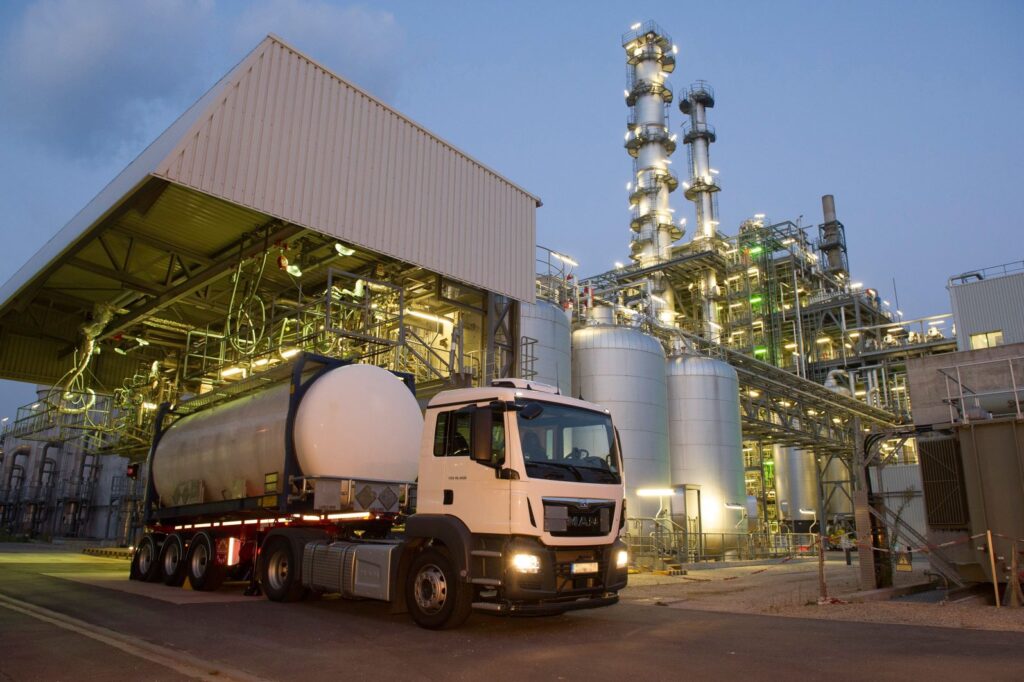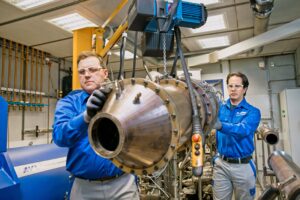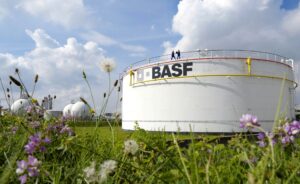
Chemicals being delivered at a BASF plant.
BASF SE is a leading global chemical group headquartered in Ludwigshafen am Rhein, Germany. The company offers innovative solutions for various industries, including the automotive and commercial vehicle industries.
With its mission statement “We create chemistry for a sustainable future”, BASF is active in 93 countries and is a global leader in research and development within the chemical industry. With more than 150 years of success and a unique Verbund concept in this form, sustainable solutions are promoted, and the full potential of chemistry is utilized. This includes a knowledge network in which the industry’s leading team works with its experts and external partners on solutions for current global challenges.

Sustainable mobility powered by chemistry
BASF is actively involved in the automotive and commercial vehicle industry – its largest customer segment. The Global Automotive Steering Committee (GASC) was founded over ten years ago to bundle the activities in the extensive product portfolio and define strategic positioning.
Its members are representatives from the Monomers, Performance Chemicals (lubricants, additives, automotive fluids), Coatings (surface treatment and automotive coatings), Performance Materials (engineering plastics), Environmental Catalyst and Metal Solutions (ECMS, precious metal services and recycling) and Battery Materials divisions.
Together with partners, the BASF Group is driving research and innovation in all areas in order to develop sustainable solutions for the automotive industry. Special emphasis is placed on reducing emissions, thermal management, electromobility, lightweight construction and more efficient fuels.
Future-proof exhaust emissions control for combustion engines
Despite ever-improving emission standards and increasing fuel efficiency, fossil-fueled internal combustion engines (ICEs) emit exhaust gases. Cars, trucks, construction and agricultural machinery that run on diesel fuel are the source of carbon monoxide (CO), nitrogen oxides (NOx) and particulate matter, for example. These pollute both the environment and people.
As the world’s leading supplier of mobile emissions control technologies (catalysts), BASF ECMS helps to protect people and the environment with cost-effective exhaust gas purification technologies. BASF’s research and development activities are developing new technologies for internal combustion engines to meet increasingly stringent emissions regulations and keep our customers competitive.
Compliance with strict emission limits, such as Euro VI, is a technical challenge. Exhaust gases such as CO and NOx must be reduced, as must soot. Exhaust gas purification systems for diesel engines consist of several components that work together to improve air quality and increase fuel efficiency.
In most cases, a diesel oxidation catalyst (DOC) is installed upstream to remove harmful emissions such as hydrocarbons (HC), followed by a soot filter, then selective catalytic reduction (SCR) and ammonia oxidation catalysts (AMOx) to remove NOx and ammonia. With its commitment to developing chemistry for a sustainable future, BASF is working worldwide to continuously improve exhaust gas purification for internal combustion engines, including for compressed natural gas and hydrogen.
Hydrogen combustion engines and fuel cells
On the way to climate-neutral mobility, efforts are underway in industry to use hydrogen as a fuel in internal combustion engines (H2-ICE) and fuel cells. The advantage of hydrogen as a fuel is that it can be produced in an environmentally friendly way through the electrolysis of water using renewable energy and its combustion produces almost no hydrocarbon-based exhaust gases.
However, an H2-ICE engine still requires an aftertreatment system to meet the very low NOx limits and to avoid hydrogen residues. BASF ECMS has therefore investigated the impact of the higher water content in the exhaust gas of a H2-ICE engine on the components in the aftertreatment system and developed new layouts to meet the required limits and support customers in the introduction of this new propulsion solution. BASF ECMS is also developing catalysts and catalyst-coated membranes (CCM) for hydrogen fuel cells.
Verdium™ – Recycled metals in exhaust gas catalysts
In addition to reducing emissions from ICEs, BASF also focuses on reducing the CO2 footprint of our products and efficient use of resources through the circular economy. The company recently started offering 100% recycled metals from the platinum group for catalyst products under the name Verdium™, which reduces the carbon footprint by up to 97% compared to conventional mining materials. With Verdium™, customers can reduce their Scope 3 emissions and verify their CO2 reductions. UL Solutions has validated the value chain control and mass balance approach as an independent third party.
GLYSANTIN® ELECTRIFIED® – Coolants for modern powertrains
Just like any powertrain technology, hydrogen-powered engines require proper thermal management to ensure smooth operations. BASF’s GLYSANTIN® FC G20® ELECTRIFIED® is a coolant especially developed for FCEV (Fuel Cell Electric Vehicles). The product contains a specifically developed and patented low electrical conductivity inhibitor package allowing for optimal protection against corrosion, frost and overheating while maintaining a stable and low electrical conductivity. This is of particular importance and contributes to increased safety of the whole (fuel cell) electric system.
Transformation to electromobility

As automotive and commercial vehicle manufacturers strive for sustainable, efficient and powerful electric vehicles (EVs), innovative materials and solutions are more important than ever. From the use of lightweight materials, advanced battery materials and protective coatings to smart solutions developed specifically for electrified and autonomous vehicles, the market and requirements for EVs are evolving rapidly.
Cathode materials for high-performance batteries
As we move towards more affordable and powerful electric vehicles, innovation in battery material development is needed to enable extended range, shorter charging times, safer and longer-lasting batteries for EVs. BASF is a leading supplier of cathode materials (CAM) for the lithium-ion battery market and supplies the high-performance CAM to the world’s largest cell manufacturers and OEMs.
With production sites in key EV regions – Asia, Europe and North America – BASF is strategically positioned to provide customized solutions for customers. In addition, the company offers metal sourcing and management as well as closed-loop battery recycling solutions to reduce the carbon footprint of batteries and ensure the supply of critical metals for new batteries.
BASF’s focus is mainly on the volume and power segment with cathode material technologies such as NCA (nickel-cobalt-aluminum mixed oxide) and NCM (nickel-cobalt-manganese mixed oxide). One of the latest product developments are manganese-rich cathode materials that contain less cobalt at the same performance and lower price.
Long-lasting protection through surface treatment
With the growing popularity of EVs, new challenges arise in the design of platforms and battery systems. BASF’s offering includes a customized product portfolio of automotive pretreatment and e-coat solutions. The innovative Oxsilan® technology forms a thinner and more uniform protective layer on metal surfaces to improve corrosion protection in combination with CathoGuard® technology.
Based on this, the CathoGuard® portfolio offers solutions to protect car bodies and components made of various metals and is also suitable for battery body covers. By preventing corrosion in and around the battery, BASF’s coating solutions help to extend the life and performance of the vehicle.
Performance plastics for battery packs
Many e-mobility solutions can only be successfully implemented by using highly flexible engineering plastics, polyurethane systems and special elastomers. The individual components and materials must meet high standards during normal driving and in the event of damage or accidents. Therefore, each material used must be carefully evaluated for flame resistance, electrical insulation, thermal conductivity and cooling compatibility.
BASF offers various innovative polymer solutions with applications in high-voltage batteries, battery packs, battery modules and for thermal management. Ultramid®, Ultramid® Advanced, Ultradur®, Elastollan® and the Elastolit® product family are just a few examples that make high-performance battery components a reality.
Sustainability along the entire value chain
BASF is working towards decoupling growth from resource consumption and moving from a linear economy to a circular economy. ChemCycling® and the Biomass Balance approach are two ways of using alternative raw materials that are being promoted at BASF.

The certified biomass balance approach makes it possible to offer a number of BASF products with a certain proportion of renewable raw materials. ChemCycling® is a mass balance approach for plastic waste that cannot be mechanically recycled but can be chemically reintroduced into Verbund production via a pyrolysis process.
Using a mass balance approach audited by independent auditors, the proportion of bio-based or recycled raw material is allocated to selected products manufactured in the Verbund. BASF’s products thus help to save fossil resources and reduce CO2 emissions while maintaining the same properties.
Drive forward. Together.
As a leading global chemical company, BASF works closely with its customers to develop solutions for current and future challenges such as the transformation of mobility and a more sustainable future.
Do you also want to drive ahead with BASF, and shape change responsibly? Contact them to find out more about the diversity of the company’s solutions for the automotive and commercial vehicle industry.
E-Mail: basfautomotivesolutions@basf.com
Website: www.basf.com/automotive and www.basf.com/automotive-commercial




More Stories
Some Ways How Motorists End Up in Collisions at U-Turns
Maximise Margins with Proven PPF Tactics
Finding the Car Boot Release Button – Tips and Tricks